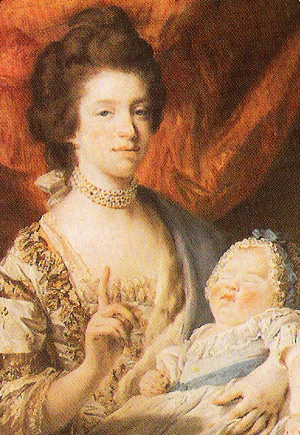Charlotte of Mecklenburg was a White Woman and Not a Mulatto

The pictures and captions are courtesy of Wikipedia from their article, Charlotte of Mecklenburg-Strelitz



Comments from Clifton Emahiser concerning the Ramsay portrait of Charlotte:
As I stated before, my best opportunity of analyzing the photograph of the painting of Charlotte was when I placed her picture from the book, National Portrait Gallery History Of The Kings & Queens Of England under a powerfully lighted magnifying lens. First of all, the portrait painter, Allan Ramsay, painted all of Charlotte’s exposed skin areas a lighter shade of skin color than the average pure-blooded Caucasian White woman! Judging from Allan Ramsay’s portrait of King George III (Charlotte’s husband), Charlotte’s skin color is even lighter than that of King George III (see pp. 98-99). King William IV was the third son of King George III and Queen Charlotte, and there is a color photographic facsimile on page 104, where there is absolutely nothing about his color or bodily features to indicate he is the least bit negroid! He does, though, have the same wavy hair that his mother had (not kinky like the blacks). He also has a somewhat wide mouth like his mother, Charlotte, which is common among some white people. While William IV did reasonably well in his naval career, he was only mediocre at being a king, but anyone who has the audacity to claim he was part black has to be stark raving mad, for it simply cannot be true! Some condemn Queen Charlotte as being part black because of her extra wide mouth, but if they would take the time to observe some of the White women around them, they would find it’s not that unusual. I purposely observed, over a period of days, several White blond women on TV that had fairly wide mouths which didn’t detract from their beauty, but Allan Ramsay, Charlotte’s portrait painter, had abolitionist reasons for painting her mouth wider than it really was! This was a criminal act on the part of Ramsay, as old as our country! What’s even more criminal, is to pass this false story as true throughout Israel Identity! Who will The Nubian Times claim they are related to next?
Evidently the painter Allan Ramsay was not aware that the Vandals were White Caucasian people, actually German, and occupied North Africa in the 5th century A.D. They were also lost Israelites (surely of the Royal tribe of Judah)! So we see, that Allan Ramsay painted quite well on most occasions, but when he didn’t approve of his subject, he had a biased paint brush! This is evidence that Allan Ramsay deliberately painted Queen Charlotte to appear negroid! We are admonished in the Bible to beware of the lying pen of the scribe. In this case it is the lying brush of the painter, which is just as evil!
LET’S TALK ABOUT CHARLOTTE’S HAIRSTYLE
In the portrait which Allan Ramsay painted of Queen Charlotte for her coronation, there is absolutely no way she wore a hairstyle that a negroid (or a mulatto for that matter) could manage to fashion into the position that she, or her servant, had cut and styled it. There is a world of difference between the hair of a negroid and that of a Caucasian! The shaft of the hair of Caucasians is round, while the hair of negroids is flat (much like that of a cassette tape, especially when the case of the cassette is broken and the flat tape is all tangled up. Most Caucasians’ hair tends to be straight in nature, although some Caucasians have wavy or even quite curly hair. To what degree a Caucasian has straight or curly hair depends upon the strength of the Arrector Pili muscle which is attached to each hair follicle from which each hair is extruded. This process may cause a curly haired Caucasian’s hair shaft to be slightly oval in shape, but not flat like a negroid. As a barber for 53 years, I have firsthand knowledge of this, and there is absolutely no comparison between the two!
Even though Allan Ramsay defrauded with his paint brush, he did quite well in portraying Charlotte’s hairstyle for her coronation, which we shall examine in minute detail. When we inspect Charlotte’s 2½ x 311/16 inch printed facsimile of her painted portrait, the first thing to be noticed are eleven individual ringlets of blond hair hanging like bangs from the right side of her forehead at the hair line. Because the left side of her forehead at the hairline is shaded it is not as clear, but one can clearly see three ringlets of like nature, and one must assume there are eight more to balance out the right side for a total of twenty-two. If these hair ringlets were a little longer, they would form a circle about 1¼ inch in diameter. Inasmuch as negroid hair forms circles less than ¼ inch in diameter, it would be utterly impossible for Charlotte to have a single drop of negroid blood! To get this frontal hairline style, it would have been necessary to section off a portion of hair about an inch wide, parallel to the hair line; then comb the sectioned hair straight down, cutting off anything in excess of about 2½ inches. And one must remember that in the 1700s, they didn’t have all the tools, gadgets and lotions found in a beauty shop today!
In her portrait, Charlotte had her head turned slightly to her left. This left a portion of her hairstyle exposed on her right side just behind her ear. Under the lighted high power magnifying lens, this clearly shows how her hairstyle, for the occasion, would have appeared from the back of her head. It appears that the back of her head was made up of vertical coils, with the hair combed horizontally into 1¼ inch diameter circuits. Judging from what can be seen on her right side, these coils of hair were 3 tiers high and about 6 or 7 rows wide, all the same size. We can be sure of this as a portion of one coil on her left side (near the same level as her chin) reveals a portion of a like-sized coil. Had Charlotte the slightest amount of negroid blood, such a hairstyle, as described here, would have been impossible!
But this still isn’t the end of the story: The book, National Portrait Gallery History Of The Kings & Queens Of England on the same page 98 with Queen Charlotte’s portrait painted by Allan Ramsay, ¶ 3, states in part: “Charlotte was no beauty, possessing small simian features, though she was not without a certain charm ....” Here the word “simian” means: “... adj. 1. of or pertaining to an ape or monkey. 2. characteristic of apes or monkeys: long simian fingers. –n. 3. an ape or monkey [1600-10; <L simi(a) an ape (prob. deriv. of simus flat-nosed <Gk simós) + -AN] -sim-i-an-i-ty ... n. ” (Webster’s 1996). With this definition, the author is intimating that Queen Charlotte appeared like an ape, and surely that was what Allan Ramsay was implying, but he had to twist his paint brush to accomplish that!
After all of this, maybe we should check to see just who published the National Portrait Gallery History Of The Kings & Queens Of England! The first thing that I notice is, it was printed and bound in Korea. On the second inside title page, the publishing company is stated as Konecky & Konecky. I searched “Konecky & Konecky” on the Internet, and it brought up Dr. Elizabeth A. Konecky, National Jewish Outreach. Also Edith Konecky, feminist and novelist, and (JWA) Jewish Woman’s Archive and European Jewish Fund, which in turn supports “Paideia”.(Paideia is a White-hating jewish organization advocating the destruction of White Europe through multiculturalism, and is the foundation of the jewess Barbara Spectre. Click here for more on Paideia.)
There is one thing more that we need to discuss about Allan Ramsay’s portrait of Queen Charlotte, and that is the extra dark shadow on the left side of her nose. When placing her printed facsimile under a powerfully lighted magnifying lens, and placing a white sheet of paper over her shadowed left side, the right side of her nose appears quite natural and not out of proportion in any way. Since the left side of her nose is obscure because of the extra dark painted shadow, one must assume that both sides of her nose are normal and well proportioned! When analyzed very carefully, it is quite obvious she was not “flat-nosed” like an ape. However, on the other hand, we know other kinds of people who are! It would have been better, had Allan Ramsay kept his political frustrations over the then heated issue of abolition to himself! Rather, Ramsay should have redirected his frustrations toward the Moslems who were raiding southern Europe and taking White slaves back to Africa and selling them to tyrant nonwhite chieftains (especially White women and children) to satisfy their sexual lusts.
“Angelika Schmiegelow Powell, Slavic Librarian at the University of Virginia Library - and herself a native of Mecklenburg, Germany - prepared the graphic materials for this exhibit, which was shown in 1994, in Charlottesville, VA, one of the towns in the New World named after the royal bride; and simultaneously in Mecklenburg-Strelitz, Germany, the Queen’s birthplace. A Library Faculty Research grant from the University of Virginia Library supported the composition of two sets of 30 pictures depicting scenes, monuments and personages of Queen Charlotte’s life and time. The English set is now permanently housed in the Albemarle County Historical Society Archive. The German edition was deposited in the Stadtmuseum Neustrelitz in Mecklenburg-Vorpommern, Germany.
“Jean L. Cooper, Systems Librarian at the University of Virginia Library, suggested the creation of a World Wide Web hypertext document of this exhibit for global viewing. A second Library Faculty Research grant sponsored this cooperative pilot project. Cooper formatted, rearranged, and selected most of the added English texts for the World Wide Web edition of the exhibit. She also scanned all the pictures. Angelika Powell translated the English texts into German.
“In May 1994, Werner K. Sensbach read through 440 of Queen Charlotte’s surviving letters, addressed to her favorite brother, Grand Duke Charles II of Mecklenburg-Strelitz, which are kept in the Mecklenburgisches Landeshauptarchiv in Schwerin, Germany. The director of the archive generously agreed to provide photocopies of 460 royal letters for the University of Virginia Library, and granted permission to quote excerpts from them in English and German translations in this hypertext document. Werner Sensbach translated these excerpts from the difficult 18th century French letters into English. Charles Rice, of the University of Virginia Library, prepared the English translation of eight-year old Wolfgang Amadeus Mozart’s French dedication letter to Queen Charlotte for his Opus 3 ....”






 Please click here for our mailing list sign-up page.
Please click here for our mailing list sign-up page.







